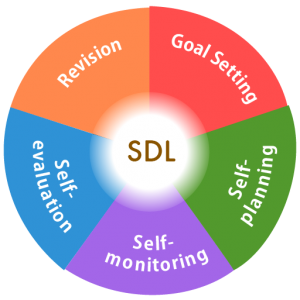Knowles (1975) defines self-directed learning (SDL) as a process in which individuals take the initiative to diagnose their own learning needs, formulate their own learning goals, identify resources for learning, choose and implement the appropriate learning strategies, and evaluate their own learning outcomes. Williamson (2007) points out that self-direction is the basis of all learning, whether formal or informal. Self-directed learning may be viewed as a process of learning where individuals take the primary responsibility in the learning process, as well as a set of personal attributes or personal characteristics of the learner (Brockett & Hiemstra, 1991; Caffarella, 1993; Merriam, Caffarella, & Baumgartner, 2007).
As a pedagogical approach, SDL identified as life and career skills necessary to prepare students for education and workforce, has two important characteristics: (a) it requires students to take personal responsibility for their own learning, and (b) the SDL process often involves the student’s interactions with the teacher as well as with other learners (Brockett & Hiemstra, 1991). Students’ personal responsibility in learning involves students taking ownership of their learning, setting learning goals, and accepting responsibility for their thoughts and actions (Hiemstra & Brockett, 1994). In essence, the decision of learning begins and resides with the learner; with the learner maintaining control for many learning decisions (Banz, 2009; Hiemstra, 1982). However, it is important to note that learning usually takes place within a social context involving the teacher as well as other students (Hew, Cheung & Lim, 2013). In other words, taking personal responsibility over one’s learning does not exclude a learner from working with the teacher or his peers (Banz, 2009). SDL as a teaching-learning transaction, therefore, involves negotiation between the teacher and learners about the learning goals, learning methods and activities, and assessment of learning outcomes (Brockett & Hiemstra, 1991). It also involves interactions with other students which could lead to deeper understanding of and further interests into the subject or topic being studied (Banz, 2009).
KEY COMPONENTS AND INDICATORS OF SDL
The operational framework of SDL includes five essential components: goal setting, self-planning, self-monitoring, self-evaluation and revision. Table 1 presents the description of each SDL indicator.

SDL Indicators | Description |
|---|---|
Goal setting |
|
Self-planning |
|
Self-monitoring |
|
Self-evaluation |
|
Revision |
|
Table 1. SDL indicators and its description
Reference:
- Banz Jr, R. N. (2009). Exploring the personal responsibility orientation model: Self-directed learning within museum education. The Pennsylvania State University.
- Brockett, R. G., & Hiemstra, R. (1991). A conceptual framework for understanding self-direction in adult learning. Self-direction in adult learning: Perspectives on theory, research, and practice, 18-33.
- Caffarella, R. S. (1993). Self-directed learning. New directions for adult and continuing education, 57, 25-35.
- Hew, K. F. T., Cheung, W. S., & Lim, K. H. (2013). Self-directed learning of undergraduate student: motivators and barriers. In 2nd International Conference on Social Science and Education, ICSSE 2013.
- Hiemstra, D. R. (1982). Self-directed adult learning: Some implications for practice.
- Hiemstra, R., & Brockett, R. G. (1994). Resistance to self‐direction in learning can be overcome. New directions for adult and continuing education, 1994(64), 89-92.
- Knowles, M. (1975). Self-Directed Learning: A Guide for Learners and Teachers.
- Merriam, S. B., Caffarella, R. S., & Baumgartner, L. M. (2007). Learning in adulthood: A comprehensive guide.
- Williamson, S. N. (2007). Development of a self-rating scale of self-directed learning. Nurse researcher, 14(2).

